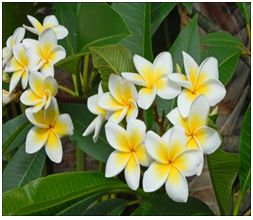
Botanical Name – Plumeria alba L.
Common Name – frangipani, champa
Classification –
Kingdom – plantae
Division –Magnoliophyta
Class – Magnoliopsida
Order – Gentianales
Family – Apocynacea
Genus – Plumeria
Species - alba
Characteristics Of Family Apocynacea–
This is also called Dogbane family . Herbs, shrubs and trees, often twining, usually with white latex; leaves are alternate, simple, exstipulate, usually opposite or whorled, entire margin with latex; flowers’ hermaphrodite, actinomorphic, hypogynous; calyx free or united; corolla gamopetalous, 5 lobed, campanulate or funnel-shaped, valvate or twisted; androecium epipetalous, introrse; gynoecium bicarpellary, syncarpous, ovary superior, united by the styles only; fruit-follicle or berry; seeds with crown of hairs.
Habitat - Coastal thickets and limestone forests at low elevations and ascending to lower montne areas.
Distribution - Naturalised in Aisa, India : Uttar Pardesh , Madhya Pardesh, Assam.
Status – Least concern
Plant description -
Whites frangipani can grow as either a small shrub or tree ranging in height from 0.9 – 6.1 m with widely spaced thick succulent branches that are often covered with knob by protuerances.
The leaves are clustered near the tips of the branches. They have a characteristic obovate shape and the tip of the leaf is rounded , rather than pointed as it is in other species.
The flowers of this species are borne in clusters that at the ends of the branches on a long thick stalk. each inflorescence contains many white flowers with a small yellow center. Flowers contain five petals that are fused at the base in a short funnel-shaped tube which gradually widens as the lobes of the petals are spread out.
The fruit of this species is a dry follicle which splits along one side to release the winged seeds.
Uses
The latex from the stem is caustic. It is used for treating ulcers, dartre (skin diseases) and scabies.
The flowers are bitter and caustic. They are an ingredient in a complex pectoral syrup for treating chest coughs and grippe.
The seeds are used in the treatment of dysentery (bloody flux).
A white latex exudes abundantly from areas of damage on the plant. It is used medicinally.
The root bark is depurative and purgative, causing thirst. It is used in the treatment of blennorrhagia, herpes and syphilis. The root bark is used externally as a lotion on syphilitic ulcers, administered as powder macerated in sugar-water, wine or beer.
The light brown wood is hard, heavy, and tough. It is used in carpentry where the tree grows to sufficient size. The wood is used for fuel.